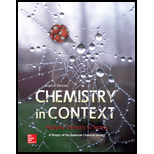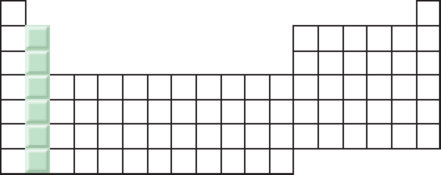
Chemistry in Context
8th Edition
ISBN: 9780073522975
Author: American Chemical Society
Publisher: McGraw-Hill Education
expand_more
expand_more
format_list_bulleted
Textbook Question
Chapter 2, Problem 9Q
Consider this representation of a periodic table.

- a. What is the group number of the shaded column?
- b. Which elements make up this group?
- c. What is the number of electrons for a neutral atom of each element in this group?
- d. What is the number of outer electrons for a neutral atom of each element of this group?
Expert Solution & Answer
Trending nowThis is a popular solution!

Students have asked these similar questions
Obtain 2-methylbutanoic acid by malonic or acetylacetic synthesis (indicate the formulas of the compounds involved).
EFFICIENTS
SAMPLE READINGS
CONCENTRATIONS
Pigiadient)
TOMATO SAUCE (REGULAR)
TOMATO (REDUCED SALT)
TOMATO SAUCE (REGULAR)
TOMATO (REDUCED SALT)
58
6.274
3.898
301.7
151.2
14150
5.277
3.865
348.9
254.8
B
5.136
3.639
193.7
85.9
605
4.655
3.041
308.6
199.6
05
5.135
3.664
339.5
241.4
0139
4.676
3.662
160.6
87.6
90148
5.086
3.677
337.7
242.5
0092
6.348
3.775
464.7
186.4
PART3
5.081
3.908
223.5
155.8
5.558
3.861
370.5
257.1
4.922
3.66
326.6
242.9
4.752
3.641
327.5
253.3
50
5.018
3.815
336.1
256.0
84
4.959
3.605
317.9
216.6
38
4.96
3.652
203.8
108.7
$3
5.052
3.664
329.8
239.0
17
5.043
3.767
221.9
149.7
052
5.058
3.614
331.7
236.4
5.051
4.005
211.7
152.1
62
5.047
3.637
309.6
222.7
5.298
3.977
223.4
148.7
5.38
4.24
353.7
278.2
5
5.033
4.044
334.6
268.7
995
4.706
3.621
305.6
234.4
04
4.816
3.728
340.0
262.7
16
4.828
4.496
304.3
283.2
0.011
4.993
3.865
244.7
143.6
AVERAGE
STDEV
COUNT
95% CI Confidence Interval (mmol/L)
[Na+] (mg/100 mL)
95% Na+ Confidence Interval (mg/100 mL)
If we have two compounds: acetone (CH₃COCH₃) and acetic acid (CH₃COOH), applying heat to them produces an aldol condensation of the two compounds. If this is correct, draw the formula for the final product.
Chapter 2 Solutions
Chemistry in Context
Ch. 2.1 - Prob. 2.3CTCh. 2.6 - Prob. 2.15CTCh. 2.7 - Prob. 2.17CTCh. 2.7 - Prob. 2.19SCCh. 2.7 - The indoor tanning industry runs a public...Ch. 2.7 - Prob. 2.21CTCh. 2.8 - Prob. 2.22CTCh. 2.8 - Prob. 2.23YTCh. 2.11 - Prob. 2.27CTCh. 2.13 - Prob. 2.30CT
Ch. 2.13 - Prob. 2.32CTCh. 2 - How does ozone differ from oxygen in its chemical...Ch. 2 - Prob. 2QCh. 2 - Prob. 3QCh. 2 - Prob. 4QCh. 2 - Prob. 5QCh. 2 - Prob. 6QCh. 2 - a. What is a Dobson unit? b. Does a reading of 320...Ch. 2 - Using the periodic table as a guide, specify the...Ch. 2 - Consider this representation of a periodic table....Ch. 2 - Give the name and symbol for the element with this...Ch. 2 - Give the number of protons, neutrons, and...Ch. 2 - Give the symbol showing the atomic number and the...Ch. 2 - Prob. 13QCh. 2 - Assuming that the octet rule applies, draw the...Ch. 2 - Prob. 15QCh. 2 - Consider these two waves representing different...Ch. 2 - Prob. 17QCh. 2 - Prob. 18QCh. 2 - Arrange these types of radiation in order of...Ch. 2 - The microwaves in home microwave ovens have a...Ch. 2 - Ultraviolet radiation is categorized as UVA, UVB,...Ch. 2 - Prob. 22QCh. 2 - Prob. 23QCh. 2 - Prob. 24QCh. 2 - Prob. 25QCh. 2 - The following free radicals all play a role in...Ch. 2 - a. How were the original measurements of increases...Ch. 2 - Prob. 28QCh. 2 - The EPA has used the slogan Ozone: Good Up High,...Ch. 2 - Nobel Laureate F. Sherwood Rowland referred to the...Ch. 2 - Prob. 31QCh. 2 - Prob. 32QCh. 2 - Prob. 33QCh. 2 - Prob. 34QCh. 2 - Prob. 35QCh. 2 - Prob. 36QCh. 2 - The average length of an OO single bond is 132 pm....Ch. 2 - Prob. 38QCh. 2 - Prob. 39QCh. 2 - Prob. 40QCh. 2 - All the reports of the damage caused by UV...Ch. 2 - Prob. 42QCh. 2 - Prob. 43QCh. 2 - Prob. 44QCh. 2 - Development of the stratospheric ozone hole has...Ch. 2 - Prob. 46QCh. 2 - One mechanism that helps break down ozone in the...Ch. 2 - Polar stratospheric clouds (PSCs) play an...Ch. 2 - Prob. 49QCh. 2 - Prob. 50QCh. 2 - Resonance structures can be used to explain the...Ch. 2 - Prob. 52QCh. 2 - Prob. 53QCh. 2 - Many different types of ozone generators...Ch. 2 - The effect a chemical substance has on the ozone...Ch. 2 - Prob. 56Q
Additional Science Textbook Solutions
Find more solutions based on key concepts
True or false? Some trails are considered vestigial because they existed long ago.
Biological Science (6th Edition)
Sea turtles have disappeared from many regions, and one way of trying to save them is to reintroduce them to ar...
MARINE BIOLOGY
Give the IUPAC name for each compound.
Organic Chemistry
2. Define equilibrium population. Outline the conditions that must be met for a population to stay in genetic e...
Biology: Life on Earth (11th Edition)
Identify each of the following reproductive barriers as prezygotic or postzygotic. a. One lilac species lives o...
Campbell Essential Biology with Physiology (5th Edition)
Why are mutants used as test organisms in the Ames test?
Laboratory Experiments in Microbiology (12th Edition) (What's New in Microbiology)
Knowledge Booster
Learn more about
Need a deep-dive on the concept behind this application? Look no further. Learn more about this topic, chemistry and related others by exploring similar questions and additional content below.Similar questions
- If we have two compounds: acetone (CH3COCH3) and acetic acid (CH3COOH); if we apply heat (A), what product(s) are obtained?arrow_forwardQUESTION: Fill out the answers to the empty green boxes attached in the image. *Ensure you all incorporate all 27 values (per column)*arrow_forwardYou need to make a buffer by dissolving benzoic acid and sodium benzoate in water. What is the mass of benzoic acid that you would weigh out, in mg, to create 50 mL of a buffer at pH = 4.7 that will change pH no more than 0.10 units with the addition of 0.001 moles of acid or base? Enter just the answer without the units (mg) - just the number will do!arrow_forward
- Give the organic product: O A O B Ос ○ D -NH–CH3 + CH3 CH3 NEN C ? A CH3 CH3 NH- CH3 B CH3 CH3 N=N- C CH3 CH3 N=NNH CH3 D CH3 N=N CH3 NHCH3 LNH CHOarrow_forwardFinish the reaction- hand written pleasearrow_forwardGive the organic products: (benzyne) Br ? CH3 + K* :NH, liq NH3 HINT: Two products are formed. Each is a substituted aniline; they are isomers of each other. NH2 II I H₂N. CH3 CH3 III Select one: ○ A. I and II ○ B. I and III O C. I and IV O D. II and III O E. III and IV H₂N CH3 IV CH₂-NH2arrow_forward
- Predict the major products of this organic reaction: HBr (1 equiv) cold ? Some important notes: • Draw the major product, or products, of this reaction in the drawing area below. • You can draw the products in any arrangement you like. • Pay careful attention to the reaction conditions, and only include the major products. • Be sure to use wedge and dash bonds when necessary, for example to distinguish between major products that are enantiomers. • Note that there is only 1 equivalent of HBr reactant, so you need not consider the case of multiple additions. Erase something Explanation Check 2025 McGraw Hill LLC. All Rights Reserved. Terarrow_forwardQ14. Fill this chart: (please refer to ppt notes/browser to answer these questions) What alcohol is also called wood alcohol? What is the common name of ethanol? Draw the structure of phenol and thiophene? Are bigger chain alcohol like heptanol and octanol are soluble or insoluble in water and explain it ? Are ethers soluble or insoluble in water? What suffix and prefix are used for alcohol while naming alcohol and ether? What the process called when we add water to any alkene to make alcohol? Q16. Draw the diagram of following aromatic compound (practice from previous module) Aniline Phenol Benzoic acid Methyl benzoate Q17. a. Write the oxidation reactions for the 2 propanol. b. Write the oxidation reaction of the ethanol.arrow_forwardQuestion 11 of 18 (1 point) Question Attempt: 3 of How many signals do you expect in the 'H NMR spectrum for this molecule? Br Br Write the answer below. Also, in each of the drawing areas below is a copy of the molecule, with Hs shown. In each copy, one of the H atoms is colored red. Highlight in red all other H atoms that would contribute to the same signal as the H already highlighted red. Note for advanced students: In this question, any multiplet is counted as one signal. Number of signals in the 'H NMR spectrum. 1 For the molecule in the top drawing area, highlight in red any other H atoms that will contribute to the same signal as the H atom already highlighted red. If no other H atoms will contribute, check the box at right. No additional Hs to color in top molecule Check For the molecule in the bottom drawing area, highlight in red any other H atoms that will contribute to the same signal as the H atom already highlighted red. If no other H atoms will contribute, check the box…arrow_forward
arrow_back_ios
SEE MORE QUESTIONS
arrow_forward_ios
Recommended textbooks for you
 Introductory Chemistry: A FoundationChemistryISBN:9781337399425Author:Steven S. Zumdahl, Donald J. DeCostePublisher:Cengage Learning
Introductory Chemistry: A FoundationChemistryISBN:9781337399425Author:Steven S. Zumdahl, Donald J. DeCostePublisher:Cengage Learning
 Living By Chemistry: First Edition TextbookChemistryISBN:9781559539418Author:Angelica StacyPublisher:MAC HIGHER
Living By Chemistry: First Edition TextbookChemistryISBN:9781559539418Author:Angelica StacyPublisher:MAC HIGHER- Chemistry: Matter and ChangeChemistryISBN:9780078746376Author:Dinah Zike, Laurel Dingrando, Nicholas Hainen, Cheryl WistromPublisher:Glencoe/McGraw-Hill School Pub Co
 World of Chemistry, 3rd editionChemistryISBN:9781133109655Author:Steven S. Zumdahl, Susan L. Zumdahl, Donald J. DeCostePublisher:Brooks / Cole / Cengage Learning
World of Chemistry, 3rd editionChemistryISBN:9781133109655Author:Steven S. Zumdahl, Susan L. Zumdahl, Donald J. DeCostePublisher:Brooks / Cole / Cengage Learning Introductory Chemistry: An Active Learning Approa...ChemistryISBN:9781305079250Author:Mark S. Cracolice, Ed PetersPublisher:Cengage Learning
Introductory Chemistry: An Active Learning Approa...ChemistryISBN:9781305079250Author:Mark S. Cracolice, Ed PetersPublisher:Cengage Learning

Introductory Chemistry: A Foundation
Chemistry
ISBN:9781337399425
Author:Steven S. Zumdahl, Donald J. DeCoste
Publisher:Cengage Learning


Living By Chemistry: First Edition Textbook
Chemistry
ISBN:9781559539418
Author:Angelica Stacy
Publisher:MAC HIGHER

Chemistry: Matter and Change
Chemistry
ISBN:9780078746376
Author:Dinah Zike, Laurel Dingrando, Nicholas Hainen, Cheryl Wistrom
Publisher:Glencoe/McGraw-Hill School Pub Co

World of Chemistry, 3rd edition
Chemistry
ISBN:9781133109655
Author:Steven S. Zumdahl, Susan L. Zumdahl, Donald J. DeCoste
Publisher:Brooks / Cole / Cengage Learning

Introductory Chemistry: An Active Learning Approa...
Chemistry
ISBN:9781305079250
Author:Mark S. Cracolice, Ed Peters
Publisher:Cengage Learning
Periodic Properties of Elements | Chemistry | IIT-JEE | NEET | CBSE | Misostudy; Author: Misostudy;https://www.youtube.com/watch?v=L26rRWz4_AI;License: Standard YouTube License, CC-BY
Periodic Trends: Electronegativity, Ionization Energy, Atomic Radius - TUTOR HOTLINE; Author: Melissa Maribel;https://www.youtube.com/watch?v=0h8q1GIQ-H4;License: Standard YouTube License, CC-BY